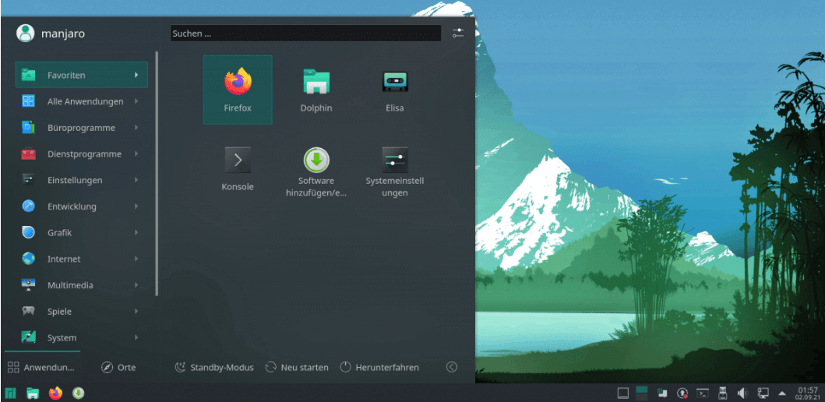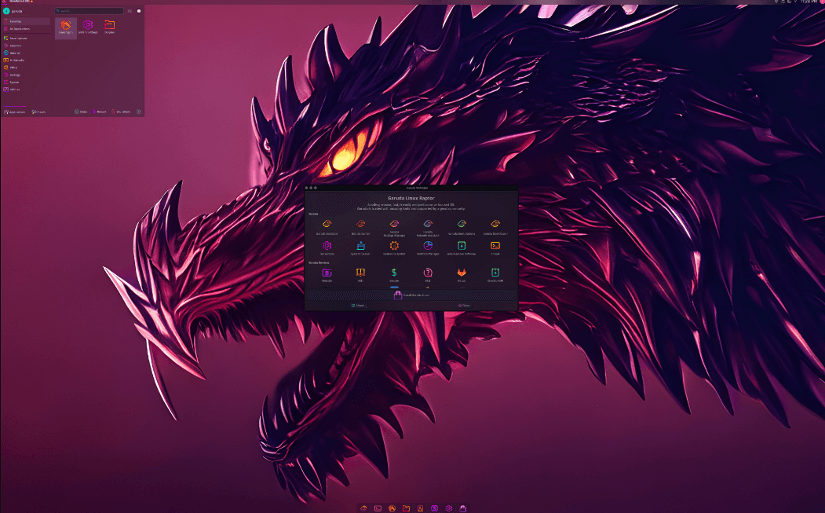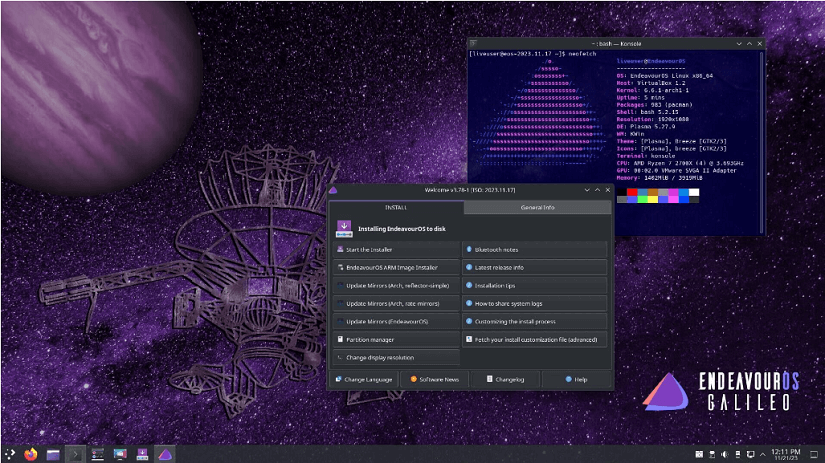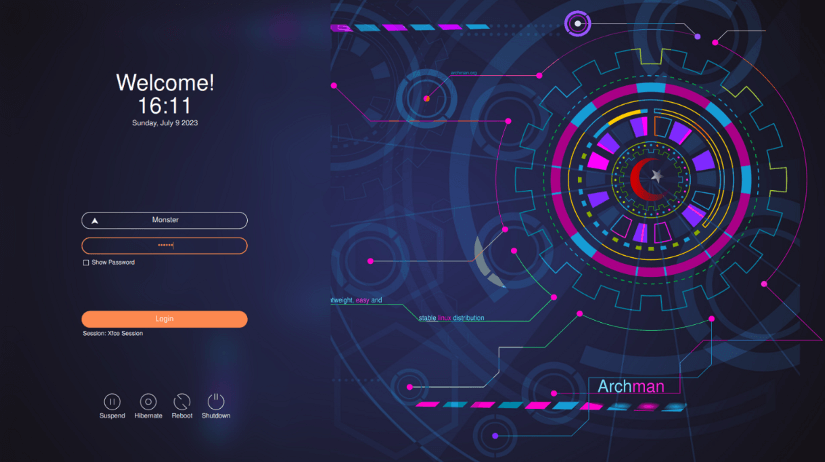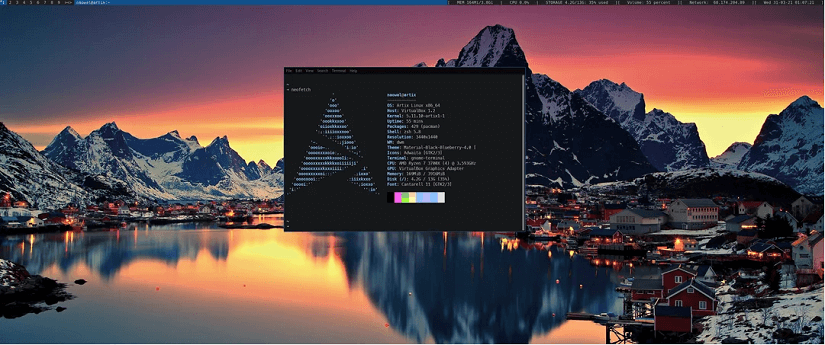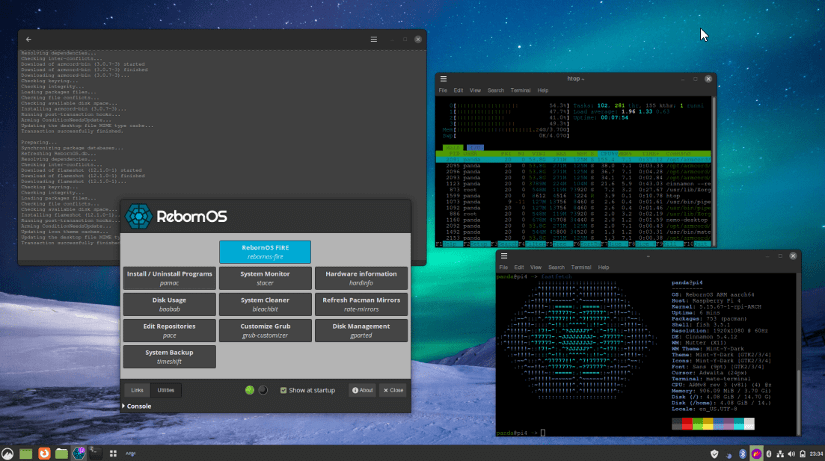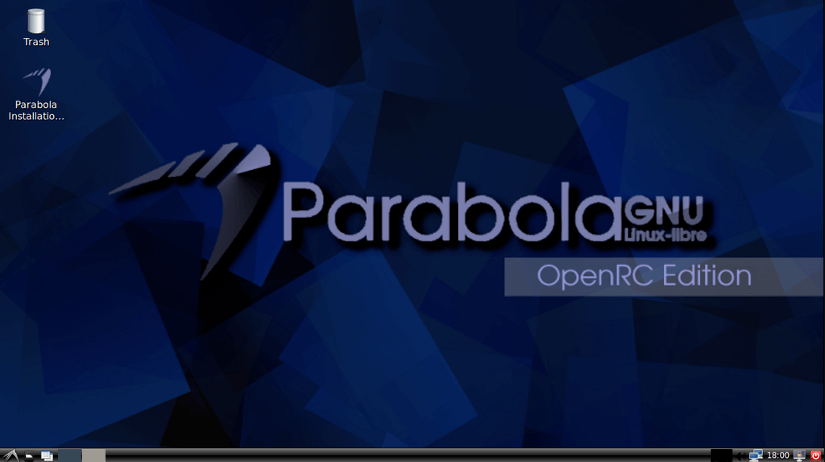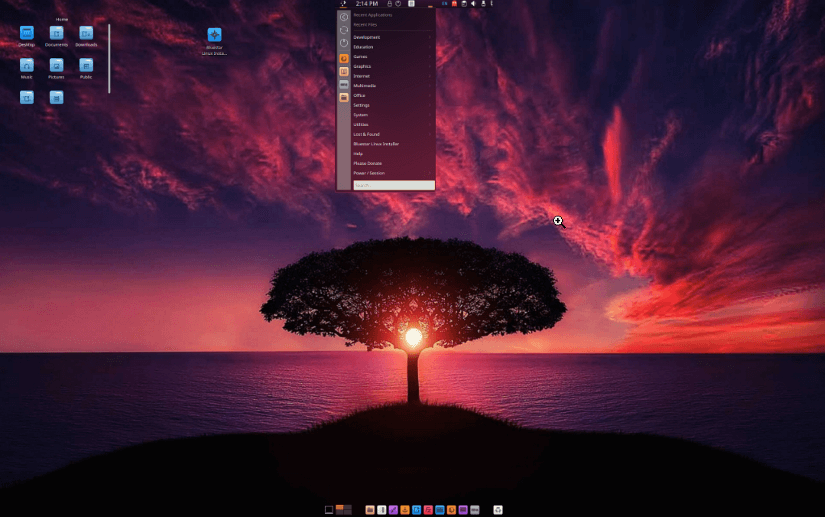FUNDAMENTALS A Complete Guide for Beginners

The top 9 best arch-based Linux distros as of 2024 are listed below:
- Manjaro
- Garuda Linux
- EndeavourOS
- ArcoLinux
- Archman
- Artix
- RebornOS
- Parabola GNU/Linux-libre
- Bluestar Linux
Arch Linux is known for its simplicity, flexibility, and user-centric design. It’s a rolling-release distribution that offers a minimalist base system and a powerful package manager called Pacman. However, for users who prefer a more customized experience or want to avoid the complexities of setting up Arch from scratch, there are several Arch-based distributions available. Read the following section of this writing for a detailed explanation of the above-mentioned Arch-based Linux distros.
1. Manjaro
Manjaro Linux, derived from Arch Linux, stands out as a rapid, user-centric, desktop-focused OS. It offers an intuitive installation procedure, automated hardware recognition, a dependable rolling-release system, support for multiple kernels, dedicated Bash scripts for graphics driver management, and extensive desktop customization capabilities. Core desktop choices include Xfce, alongside KDE, GNOME, and a minimalist Net edition customized for advanced users. Additionally, community-backed desktop variants are also available. Recommended for both adventurous beginners and seasoned users exploring a secondary distribution. Moreover, it makes sure of swift performance without obstacles, even on dated hardware.
Download Manjaro Linux
Click here to visit Manjaro Linux‘s official download page.
System Requirements of Manjaro Linux
- 4GB of memory.
- 30GB of hard disk space.
- A dual-core processor.
Key Features of Manjaro
- Manjaro ensures continuous updates without the need for OS reinstallation.
- Offers a highly responsive experience with occasional minor issues.
- Maintains Stable, Testing, and Unstable branches for rigorous software testing.
- Manjaro features Pamac as its default Package Manager, offering advanced dependency management.
- Pamac supports native packages, as well as Snaps and Flatpaks.
- Exclusive to the Gnome Edition, Gnome Layout Switcher allows users to customize their Gnome Layout.
- Manjaro Settings Manager (MSM) seamlessly integrates with Plasma Desktop and functions independently on other Desktop Environments.
- Manjaro provides a diverse range of Kernels, including LTS, the latest, and real-time options.
- Manjaro’s software manager is robust, offering access to AUR repositories.
2. Garuda Linux
Garuda Linux is a rolling release Arch Linux-based distribution that aims to provide a feature-rich & user-friendly Linux experience. The multiple desktop options, pre-installed theme, and customization options with animations & effects have made Garuda one of the aesthetic-looking Linux distros. It is free and will always remain free and open source.
Download Garuda Linux
Click here to visit Garuda’s official download page.
System Requirements of Garuda Linux
- 64-bit system.
- Minimum 30 GB Disk Storage (Recommended 40 GB).
- Minimum 4 GB RAM (Recommended 8 GB).
- Graphics Video card with OpenGL 3.3 or better.
Key Features of Garuda Linux
- Garuda’s beauty comes with its default dark mode theme. Moreover, it provides multiple desktop environment options including KDE, Xfce, GNOME, LXQt, Wayfire, Qtile, Sway, etc.
- Various pre-installed themes with bright colors, high-contrast design, and animated effects have made Garuda visually elegant.
- Shell design & layout prioritizes a GUI-friendly interface.
- One of the best choices for gaming & multimedia task performances due to its Zen Kernel specialization.
- Uses the Calamares installer for a simple and fast installation process.
- BTRFS is the default filesystem, which is a modern Copy-on-Write (CoW) filesystem for Linux.
- Uses automatic snapshots with the BTRFS filesystem and Snapper.
- Garuda uses Chaotic-AUR as a repository featuring a large selection of precompiled software.
- Garuda ships with its own browser, FireDragon, which is forked from LibreWolf.
3. EndeavourOS
EndeavourOS is a rolling release Linux distribution built on Arch Linux, aspiring to follow in the footsteps of Antergos by delivering a straightforward setup and pre-configured desktop environment atop an Arch foundation. It presents users with both offline and online installation choices. The offline installer utilizes the Xfce desktop environment by default, while the online installer allows the installation of optional software components, including various popular desktop environments.
Download EndeavourOS
Click here to visit EndeavourOS‘s official download page.
System Requirements of EndeavourOS
- 5 GB of RAM.
- Dual Core Processor (64-bit, x86-64, amd64).
- 15 GB of Harddrive space.
- Recommended to run modern EFI (UEFI) systems not on legacy (CSM) mode.
Key Features of EndeavourOS
- Outperforms MacBook Air with M1 chip in executing tasks like running NodeJS scripts.
- AUR and Pacman offer comprehensive support for research and quick solutions, aligning seamlessly with coding and deployment workflow.
- Simple, fast installation process ideal for both newcomers and experienced users.
- Minimal post-installation steps available on the wiki.
- Responsive community forum providing solutions and guidance.
- Smooth gaming experience with no CPU hiccups during non-intense moments.
- Easy installation of Nvidia drivers and swift access to Steam via pre-configured multilib support.
- User-friendly tools like reflector for optimizing download speeds and GUI package manager for simplified package management.
- Smooths out potential installation issues common with raw Arch setups, ensuring a hassle-free experience.
4. ArcoLinux
ArcoLinux, previously recognized as ArchMerge, is an Arch Linux-based distribution. Its development occurs across three branches, ArcoLinux, ArcoLinuxD, and ArcoLinuxB. ArcoLinux offers a comprehensive package with the Xfce desktop environment, alongside Openbox and i3 window managers. ArcoLinuxD, on the other hand, is a minimalist distribution equipped with scripts customized for advanced users to install any desired desktop environment and applications. And, ArcoLinuxB is a project empowering users to construct personalized distributions, alongside community editions pre-configured with desktop environments like Awesome, bspwm, Budgie, Cinnamon, Deepin, GNOME, MATE, and KDE Plasma. The latest release is ArcoLinux 24.021.
Download ArcoLinux
Click here to visit ArcoLinux‘s official download page.
System Requirements of ArcoLinux
- More than 2GHz CPU 64 bits.
- 2 GB minimum RAM, ( Recommended 4-8 RAM).
- Minimum disk space of 15-20 GB, ( Recommended 20-30 GB).
Key Features of ArcoLinux
- ArcoLinux has a strong focus on education and provides lots of resources for users who want to learn more about Linux. This includes a comprehensive wiki, tutorials, and a forum community.
- While Arch Linux itself is known for its complex installation process, ArcoLinux offers a relatively easy graphical installer that can help users get up and running quickly.
- During installation, it prompts you to select the kernel according to your GPU chipset and the communication tool you want to include in the Desktop.
- A variety of development tools are pre-installed, including Git, Python, Node.js, and several programming languages.
- Tools for system administration and customization are pre-installed, such as NetworkManager, Firewalld, and various configuration tools. Moreover, codecs and players for audio and video playback are pre-installed.
- Recently it has introduced a new desktop environment called WAYFIRE that is based on Wayland and can be installed on Intel/AMD and Nvidia alike.
- Has made it easier to share over Samba or share data over the personal network.
5. Archman
Archman Linux is a lightweight, rolling-release distribution based on Arch Linux. It incorporates the Calamares system installer and comes with a pre-set desktop environment. Additionally, Archman includes the Pamac package manager for simplified installation of software packages.
Download Archman
Click here to visit Archman‘s official download page.
System Requirements of Archman
- 64-bit compatible processor (x86-64) Processor.
- RAM minimum 1 GB (recommended 2 GB or more).
- Storage minimum 8 GB (recommended 20 GB or more).
Key Features of Archman
- Archman features the Calamares system installer, which is user-friendly and versatile.
- It uses the Pamac package manager, which is intuitive and easy to use.
- Offers a selection of preconfigured desktop environments.
- The new version comes with a customized Xfce 4.14 desktop environment.
- Added to the Archman repository is TkPacman, a lightweight graphical user interface for pacman.
- Known for its user-friendliness and accessibility, making it a good choice for both newcomers and experienced Linux users.
6. Artix
Artix Linux is essentially a spinoff or independent version of the Arch-OpenRC and Manjaro-OpenRC projects. It’s a lightweight operating system that continuously updates, and it’s built around the OpenRC init software, with options for runit and s6 as well. Artix Linux offers various editions, some with just a basic command-line interface and others with different desktop environments to choose from.
Download Artix
Click here to visit Artix‘s official download page.
System Requirements of Artix
- 64-bit compatible processor (x86-64).
- RAM minimum 512 MB, (Recommended 1 GB).
- Storage minimum 2 GB (Recommended 10GB).
- Video card with OpenGL 3.3 or later (recommended) for Graphics.
Key Features of Artix
- Artix Linux uses init systems such as OpenRC, runit, s6, or Dinit, as opposed to Arch Linux’s init systemd.
- Has its own package repositories but can use packages from Arch Linux repositories or any other derivative distribution, even packages explicitly depending on systemd.
- The Arch User Repository (AUR) can also be used.
- The latest installation media are available in a variety of desktop environments like LXDE, XFCE, MATE, Cinnamon, and KDE Plasma 5.
- Two unofficial community editions featuring GTK and Qt desktops and a larger software base are offered.
- Artix initially offered two installation environments, a base command-line ISO image and the graphical Calamares installer based on the LXQt desktop.
7. RebornOS
RebornOS is a desktop-focused Linux distribution based on Arch Linux. While the live version offers just one desktop, during installation, users can choose from various popular desktop environments and window managers. It supports Flatpak packages, optional Anbox installation for Android apps, a function enabling system rollback to an earlier date, as well as graphical tools for configuring and maintaining the system.
Download RebornOS
Click here to visit RebornOS‘s official download page.
System Requirements of RebornOS
- CPU Minimum 1.2 GHz dual-core (Recommended 2.1 GHz quad-core).
- RAM minimum 2 GB (Recommended 4 GB).
- Storage minimum 20 GB (Recommended 40 GB or more).
- Installation medium CD/DVD or USB 4 GB or more.
Key Features of RebornOS
- Graphical installer simplifying setup, ideal for beginners.
- Multiple desktop environment options like GNOME, KDE Plasma, Xfce, etc.
- Rolling release model for continuous updates and security patches.
- Community-driven development fostering collaboration and responsiveness.
- Emphasis on aesthetics, prioritizing themes, and customization.
- Additional features include universal package management, kernel selection, and file system options.
8. Parabola GNU/Linux-libre
Parabola GNU/Linux-libre is an independent derivative of Arch Linux that emphasizes freedom. Its objective is to deliver a completely free distribution based on Arch Linux packages, optimized for both i686 and x86_64 processors. The primary aim is to grant users full control over their systems by exclusively offering libre software. Recognized by the Free Software Foundation (FSF) as a fully free software distribution, Parabola GNU/Linux-libre provides a standard installation CD image alongside a live/rescue DVD image featuring MATE as the default desktop environment.
Download Parabola GNU/Linux-libre
Click here to visit Parabola‘s official download page.
System Requirements of Parabola GNU/Linux-libre
- CPU any i686 compatible machine.
- RAM Minimum 256 MB for LXDE, 1 GB for graphical installer.
- Disk Space of 800 MB for base group, 9 GB for LXDE install.
Key Features of Parabola GNU/Linux-libre
- Parabola is a fully free, simple, and lightweight operating system. Its lightweight and simple design makes it easy to extend and mold into whatever kind of system you’re building.
- All Parabola packages are built from source, in clean chroots, and with networking disabled. This is done to replace any software and artworks in the standard Arch system that fall outside the GNU guidelines.
- Supports Multiple CPU Architectures. LiveISOs, installers, and packages are provided for the armv7h, i686, and x86_64 CPU architectures.
- The Parabola project is a community-driven, “labour-of-love” effort. The community is friendly and helpful.
- Uses a rolling release model like Arch, such that a regular system update is all that is needed to obtain the latest software.
- Offers multiple user interfaces including Zsh CLI (Main live and TalkingParabola ISO), MATE (MATE live ISO), and LXDE (LXDE live ISO).
9. Bluestar Linux
Bluestar is based on Arch Linux, providing the power and flexibility of Arch with a user-friendly experience. It is available in three editions – desktop, deskpro, and developer – each customized to address the needs of various Linux users. Bluestar uses the KDE desktop environment, offering a unique and aesthetically pleasing user interface. The developers aim to provide up-to-date packages and a host of desktop and multimedia apps out of the box.
Download Bluestar Linux
Click here to visit Bluestar Linux‘s official download page.
System Requirements of Bluestar Linux
- 1 GHz (x86) Processor.
- Minimum of 1GB of RAM.
- Minimum of 6.5GB free hard space (recommended 10 GB).
Key Features of Bluestar Linux
- Bluestar can be installed permanently or run effectively as a live installer with persistent storage support.
- Comes with a pre-configured graphical installer and a pre-configured desktop environment (KDE Plasma by default).
- Intuitive package management, potentially simplified compared to Arch.
- Rolling release model for continuous updates and access to the latest software.
- Utilizes the KDE desktop environment, offering both basic and advanced versions depending on the selected flavor.
- Lightweight design, suitable for older or low-resource hardware.
- Focus on multimedia and productivity with pre-configured codecs and tools.
- Suitable for both beginners and experienced Linux users.
Comparison Among Best Arch Based Distros in Linux
To view the comparative overview of the above-discussed best Rch-based distros, please go through the following table:
| Names | Desktop Environment | Key Features | Average User Rating |
|---|---|---|---|
| Manjaro | Xfce, KDE, GNOME, etc. | User-friendly installer, pre-configured packages, good for beginners. | 8.1 |
| Garuda | KDE, GNOME, Cinnamon, XFCE, Qtile, i3wm, Sway, Hyprland, etc. | Gaming-focused features, and extensive customization options. | 8.4 |
| EndeavourOS | Xfce, KDE Plasma, GNOME, MATE, Cinnamon, Budgie, LXQt, LXDE, etc. | Minimalist approach, close to pure Arch experience. | 8.4 |
| ArcoLinux | Xfce, Cinnamon, Deepin, GNOME, i3, MATE, KDE Plasma, Openbox, etc. | Designed for beginners, pre-configured with essential tools | 8.5 |
| Archman | i3wm, Xfce, etc. | For advanced users, focuses on efficiency and customization. | 9.4 |
| Artix | Cinnamon, LXDE, LXQt, MATE, KDE Plasma, Xfce, etc. | Systemd-free init system. | 9.2 |
| RebornOS | Xfce, MATE, KDE Plasma, GNOME, etc. | Focuses on user experience, community-driven. | 8.2 |
| Parabola GNU/Linux-libre | Blackbox, Fluxbox, GNOME, IceWM, KDE, LXDE, MATE, Openbox, WMaker, Xfce, etc. | Free software, rolling release. | 8.2 |
| Bluestar Linux | KDE Plasma | Pre-configured with essential software, focuses on ease of use. | 5.3 |
Note: The average user ratings are based on the user ratings provided on Distrowatch up until 29th February 2024.
Conclusion
In summary, Arch-based distributions provide a middle ground between Arch Linux’s flexibility and user-friendly features. Whether you’re new to Linux or an experienced user, exploring these distros offers customization options and access to a supportive community. Embrace the diversity of Arch-based Linux distributions to find the perfect fit for your needs and preferences!
People Also Ask
Which distros are Arch-based?
Some of the popular & best arch-based distros are, Manjaro, Garuda Linux, EndeavourOS, ArcoLinux, ArchLabs Linux, Archman, Artix, RebornOS, Bluestar Linux, etc.
Is Arch a Debian distro?
No, Arch Linux is not a Debian distro. It is developed independently from Debian with a different philosophy and approach.
How to choose the best Arch-based Linux distro?
To ensure a smooth experience with an Arch-based Linux distro, consider the following factors:
- Check Hardware Compatibility: Verify if your hardware can run the distro smoothly and if it supports your system’s architecture (32-bit or 64-bit).
- Review Documentation: Evaluate the availability and quality of documentation to aid in installation and troubleshooting.
- Consider Installation Process: Assess the duration and ease of installation, including the availability of graphical installers or manual setup.
- Evaluate Software Repositories: Examine the software repositories to ensure they contain the packages you need and provide timely updates.
- Beginner-Friendly Distributions: If you’re new to Linux, opt for distros designed for beginners to avoid unnecessary complexities.
- Desktop Environment Assessment: Evaluate desktop environments based on visual design, available themes, customizability, and overall functionality.
Which is better Arch or Debian?
Debian is well-suited for new users and those looking for a robust and extensive package repository, while Arch is more suited for advanced users and those looking for bleeding-edge technology and customization options. It’s important to choose the one that best fits your needs and level of expertise.
Why Arch Linux is better?
Arch Linux is favored for its DIY (Do It Yourself) approach. From installing to managing, Arch Linux lets users handle everything. You decide which desktop environment to use, and which components and services to install. Moreover, it provides up-to-date software, an extensive Arch User Repository (AUR), and flexibility and customization options.
What is the Arch distro for beginners?
The Manjaro Linux provides all the benefits of Arch Linux combined with a focus on user-friendliness and accessibility. It is suitable for both newcomers and experienced Linux users alike. Besides Manjaro, ArcoLinux is a full-featured distribution that ships with the Xfce desktop, Openbox, and i3 window managers by default. Making it another suitable Arch distro for beginners.
Why Arch Linux is hard?
Arch Linux is challenging due to its DIY(Do It Yourself) approach, reliance on the command line, manual configuration, lack of GUI tools, and the need to understand Linux better. In contrast to many Linux distributions, Arch Linux lacks a user-friendly GUI installer, relying solely on a text-based interface. Consequently, installation can be difficult even for advanced users. However, these challenges offer learning opportunities, and most users can manage them with careful learning.
